How Blockchain and Cryptocurrency can (and will) radically change the existing financial system?
The Future of Capital Markets
Greetings, Lads & Gals!
Let’s analyze a very interesting topic concerning how the financial system can change radically, and what we might need to be prepared for in the near future with the rise of cryptocurrencies.
We’ve conducted for you a recent report from the World Economic Forum, which contains analysis and dialogues with hundreds of ideas of the world’s largest banks on the topic of cryptocurrencies, digital assets, and the distributed ledgers.
The report is really huge, so we will analyze only the key points.
It is important to remember that the financial market is dynamic and no one knows for sure what it will look like in the future. We can only make assumptions and possible options. This report just shows one of the possible options for what we may see very soon.
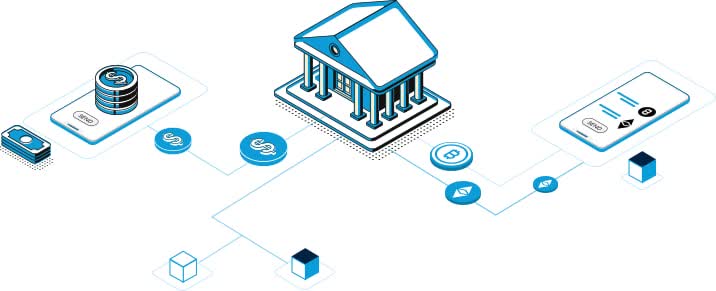
World Economic Forum
WEF
Let's start with a short introduction
Over the past few years, financial institutions have faced the need to improve their service and their system, and the need to improve things like customer service, transaction speed, and data delivery speed.
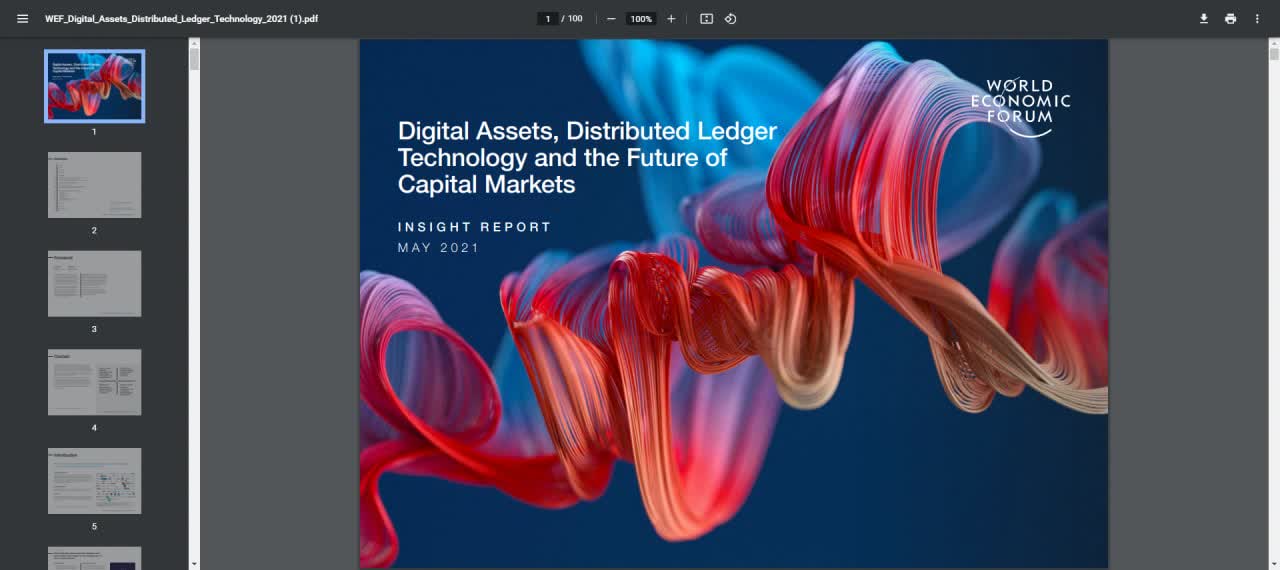
World Economic Forum
WEF
For this, many players are now considering the possibility of introducing and using a distributed ledger and blockchain.
And accordingly, depending on the technology, this can significantly reduce the cost and increase the simplicity of transactions, include more players in the financial market, and provide financial services to a huge number of people.
It is very important to understand that we are now talking about blockchain and distributed ledger technology as a technology in general.
That is, now we need to mentally distance ourselves from some specific cryptocurrencies that we already have at the moment, and think generally about the technology itself, how it can be used in the banking and financial sector.
During 2020, the World Economic Forum hosted workshops and interviews with hundreds of world leaders and experts in finances. All statistics and all data in this presentation are based on the opinions of the world’s leading companies.
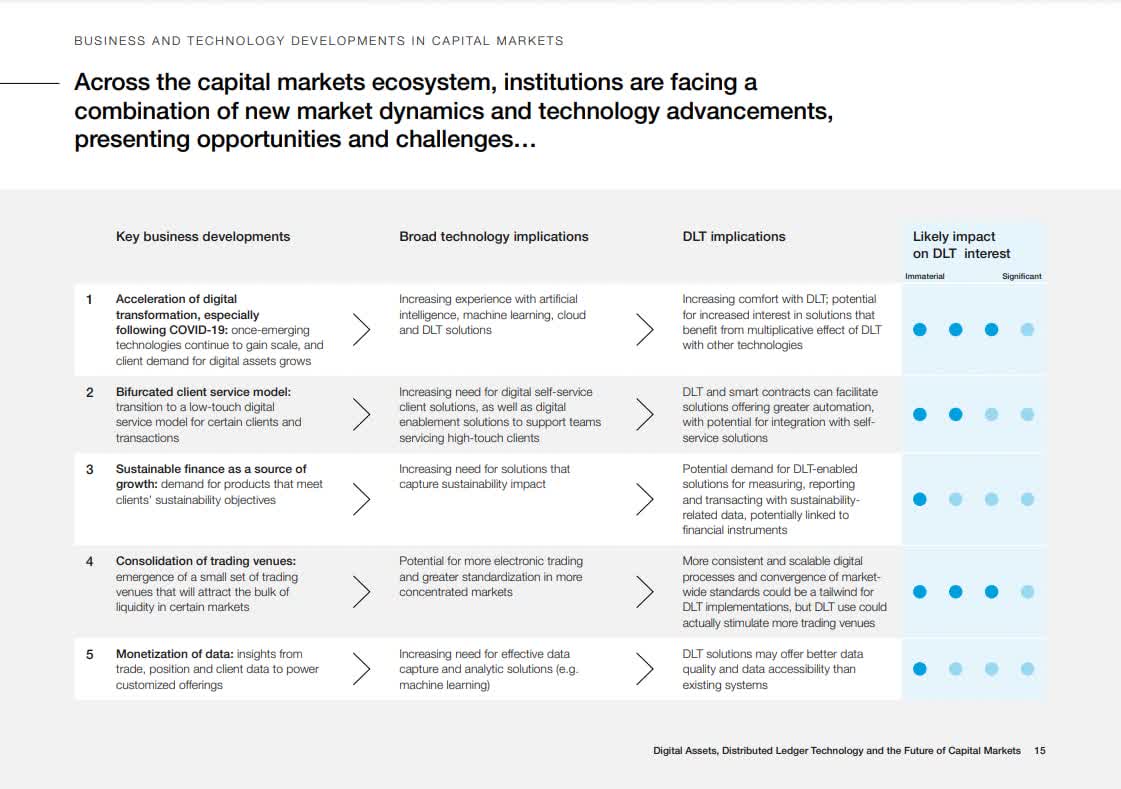
World Economic Forum
WEF
Here on this slide, we see various industries and zones of the financial world that now have certain problems that can be solved thanks to distributed ledger technology (DLT).
Here we see dots, respectively, the more dark blue dots we have, the more relevant the distributed ledger technology in a particular segment.
Let's focus only on the most basic areas
According to banks, there are now four main industries that they wish to develop.
- 1) An acceleration of digital transformation, which means that services must go online so that people no longer go to banks, but can simply be served online, especially because of Covid19 – this is very important.
- 2) Next, we have a consolidation of trading venues, which means that different platforms will have to merge with each other, that is, banks want to get away from the fact that at the moment there are many different markets where we can trade.
They want to create one or more single large markets, which will have all the liquidity of these small markets, that is, one large platform with huge liquidity.
- 3) The next point is the resolution of the issue with the preservation of assets. Banks want at the moment to ensure that client assets will be kept by clients, company assets will be kept by the company, and so on. That is, they want to invent a more convenient mechanism for managing assets so that they still remain under the control of customers.
- 4) And the last point is the increased competition. That is, new blockchain technologies will provide easier access to various new players in the financial market, who can bring new technologies to this financial market and thus increase competition and bring some new, more convenient, more efficient products.
The solution to these problems in these industries is planned to be achieved using distributed ledger technology (once again, DLT).
Here comes the question…
What is Distributed Ledger Technology?
This is when information data and processing of various operations are not stored in one place but are stored distributed among many participants in this network at different nodes.
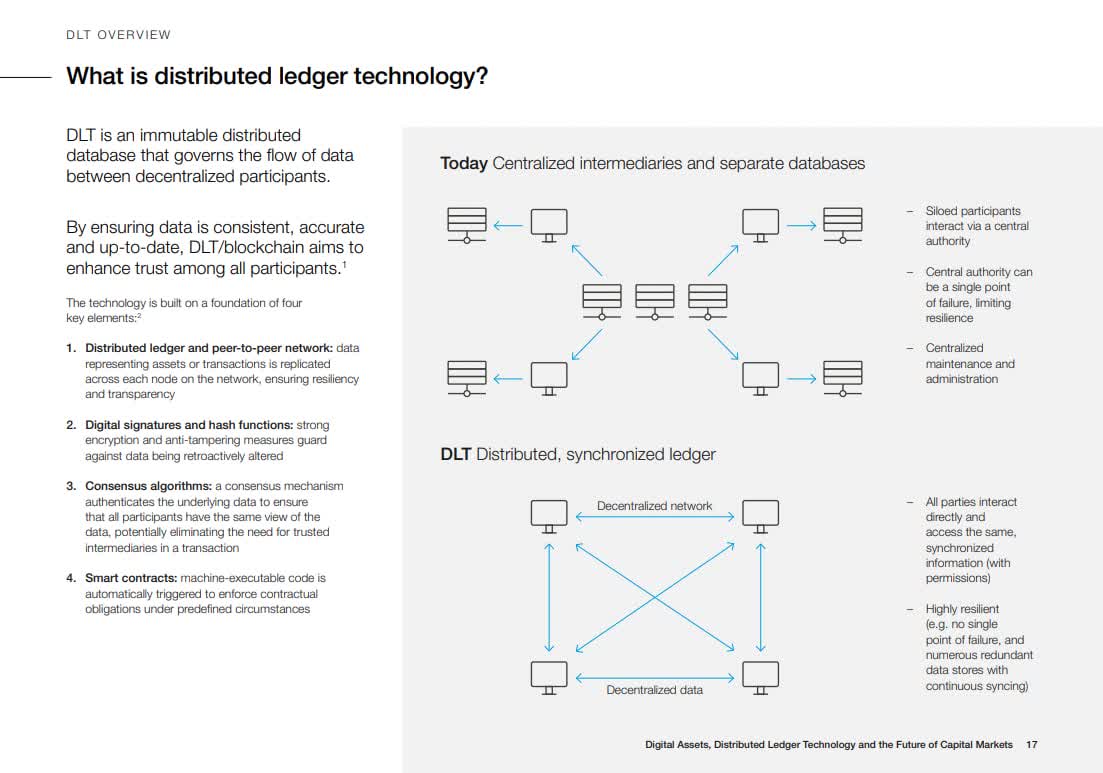
World Economic Forum
WEF
Accordingly, they constantly communicate with each other and store this data all together on themselves. That is, it is safer and in some way proves to be more efficient.
Of course, distributed ledger technology will be used not only because of its decentralization and distribution. As we said earlier, many companies at the moment are in need of high-quality, uninterrupted, and simple communication with each other, and, accordingly, blockchain technology can provide precisely this high-quality, uninterrupted communication network on a trust basis because blockchain is trust and this is very important not to waste additional resources to double-check any information.
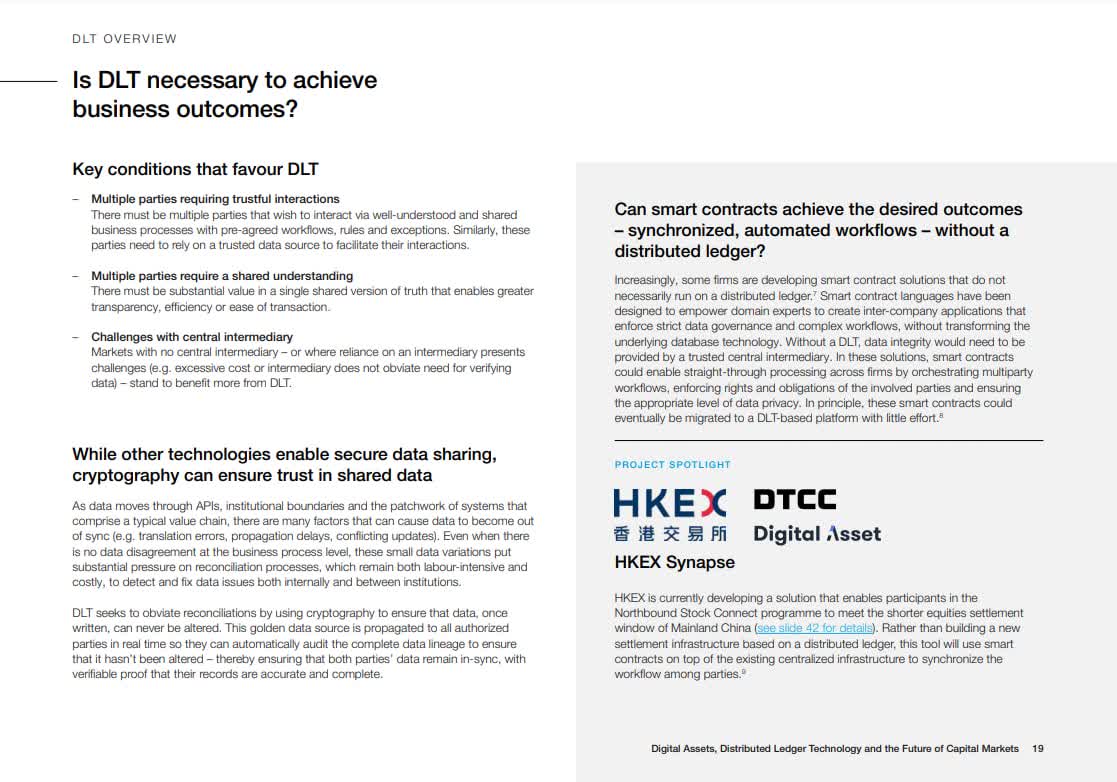
World Economic Forum
WEF
Also, besides this, a very important point is that thanks to cryptocurrency, communication will be additionally protected from various forms of attack, respectively, it will be more secure, more effective communication.
The advantage of blockchain technology is that the entire technology, even for banks, will be distributed, they will have more trust in each other, the exchange of data will be much faster since they will potentially work on the same network, and also encryption, they will be able to encrypt their data using blockchain technology, so that the information is not leaked there.
How exactly the technology will be implemented, we will consider a little later.
Now let's consider what the difficulties will be, what are the possible dangers in this new technology for banks
First of all, “potentially new cybersecurity risks” with a 51% attack possibility, can occur when more than half of the network makes incorrect data on the blockchain, which is very unlikely, but in theory, it is possible.
Also, thanks to new technology, we are opening possible unexplored holes for data leakage and privacy, which will need to be properly worked out and closed.
Also, the problem with integration and implementation of blockchain technology into the existing financial system, and into the technology that is currently working to our advantage.
And it also begs the question - how well will all this work in the long run?
The rest of the issues that will need to be resolved include operational governance and control, that is, how everything should be processed since at the moment we have (as stated) quite a limited experience with validating and auditing smart contracts, and also this particular issue include the problem with coordinating software upgrades since everything is decentralized, i.e. there’s no centralized core that’d be responsible for software upgrading on an automated mode.
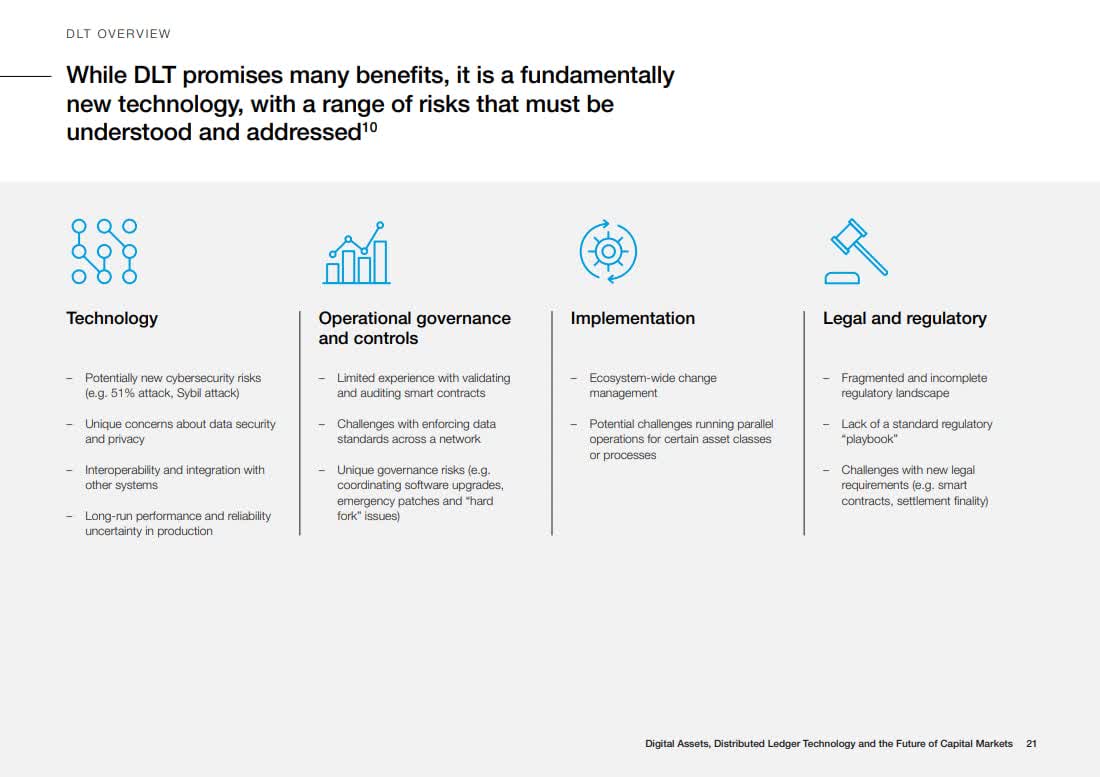
World Economic Forum WEF & Cryptocurrency
We also have a question of implementation, that is, the introduction of the system, how to properly “connect” it with the existing financial system?
And the last point is the legislative aspect, that is, the regulation and regulation of this technology, because at the moment we do not yet have any laws on how to regulate decentralized blockchain technology.
This is a very important point that will need to be addressed before this technology goes to banks.
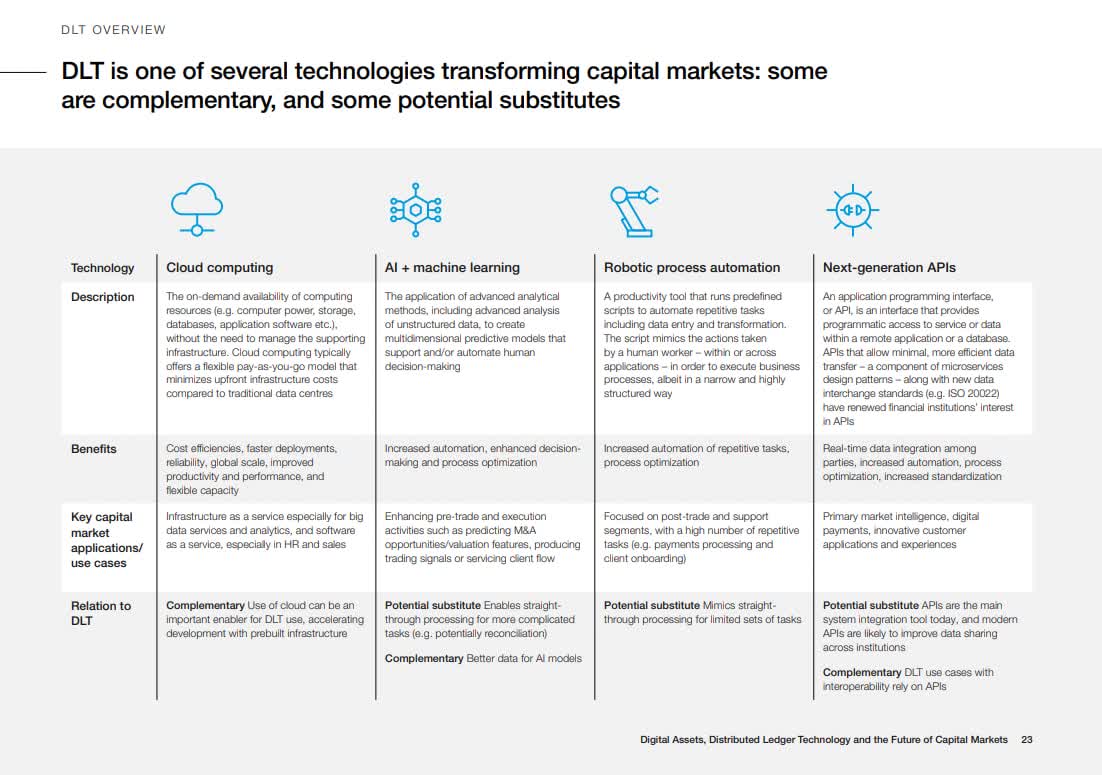
World Economic Forum WEF, Bitcoin, Banks
This is all that concerns, namely, the part with the blockchain and the distributed ledger, however, at the moment, other developments are underway in bordering parallel industries, which can also be well integrated with blockchain technology.
These include, for example, cloud computing, the development of artificial intelligence and machine learning, as well as the robotization of various workflows, which now occur manually with the human factor.
And it also includes the development of next-generation APIs, that is, the integration of various platforms and applications with each other.
Very large investments are usually made at the intersection of two technologies.
For example, think about combining blockchain with cloud computing or blockchain with machine learning. Accordingly, if there are any projects that can unite this, they will be very well appreciated.
And now we will consider various options for using the implementation of these technologies, and how they will affect our lives and our world as a whole.
As usual in life, we have various options for the development of events. Banks consider a couple of “light”, minimal options for the development of events and three more significant options that will significantly affect our future.
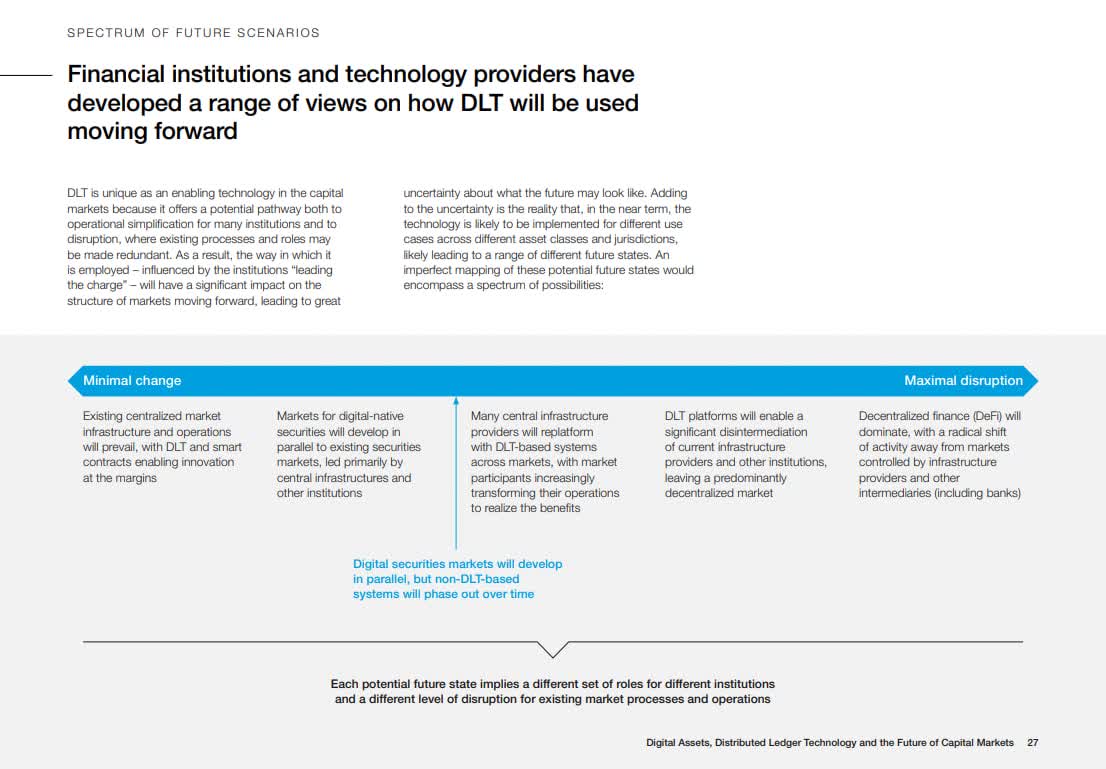
World Economic Forum WEF, Bitcoin, Banks
The more “minimal” change would be that the existing centralized market structures will remain approximately the same as they are now, but various blockchain technologies and distributed ledger technologies will still be integrated into separate areas, that is, they will simply improve the small values market, but in any case, everything will remain centralized.
The centralized financial market will remain the same, but alongside it, a decentralized financial market will be launched as well, which will operate under the same conditions as the conventional financial market.
Starting from this point, from the number of changes in the financial system that exists now (as well as the decentralized system that banks plan to implement in the future), it will be developing alongside, but over time, the traditional financial system, according to very high expectations, is likely to wither and die out eventually.
Accordingly, from here, there are at least three options for further development of events:
1) Various centralized financial infrastructures will gradually move to decentralization, that is, there will already be some kind of basis, and various new companies and new industries will be added to this basis.
2) It will turn out that almost all platforms will be decentralized, and will work on one new decentralized platform.
3) And the third option. Defi will take over the world. Accordingly, a completely new system will take the place of old financial institutions, and all companies, all various industries, where it will be expedient and reasonable, will switch to the blockchain.
Accordingly, centralization will die, only decentralization will remain.
It is very important that all these points described above can occur in stages, i.e. there can be a gradual development in steps, and maybe vice versa.
It is also worth noting that many crypto enthusiasts would most likely be very excited to see the third option happening (which, let’s be honest, will probably happen at some point in the future), and in no other way.
But the truth is always somewhere in between. It will be very difficult to come straight to such a maximalist option using cryptocurrency and blockchain in absolutely all areas because it will require huge investments from all market participants, therefore it’d be very difficult to achieve this on the spot.
Most likely, the main structures will first move to decentralization, on which all other smaller structures will depend.
Eventually, they will just catch up to it.
The main idea is that there are certain stages of development that will require the inclusion of certain players in these stages of development, and the further we move along these stages, the more exponentially the complexity behind the implementation of these technologies will grow.
Let's go back to the possible changes
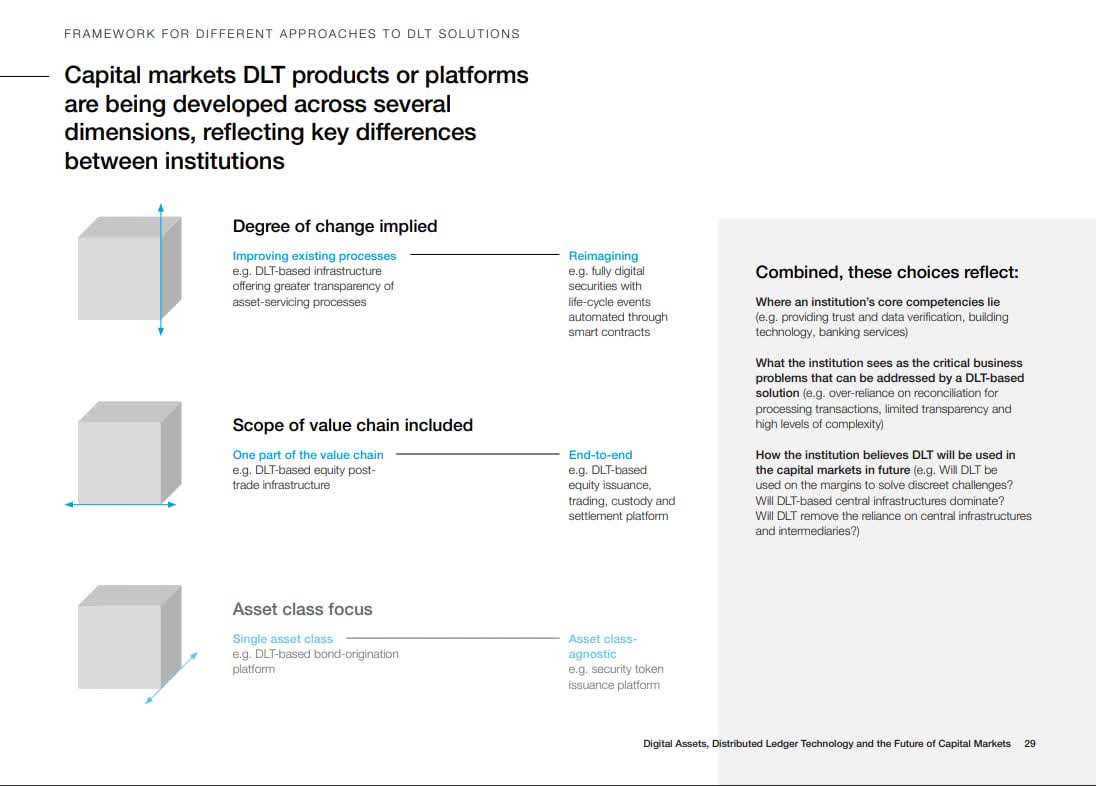
World Economic Forum WEF, Bitcoin, Digital Assets
They can be described using three key factors and an additional degree of change within these key factors.
They can just slightly improve some processes at a certain moment, or they can completely restructure the work of one or another process, and then significant changes will occur within one parameter, which will entail many other various changes subsequently.
The first point that is important here is the degree of implementation (“Degree of change implied”) of this or that new technology.
That is, we may simply have higher transparency of financial markets due to the fact that we will use distributed ledger technology, and we may get a fully automated market that can provide services in a decentralized format.
Also, the number of companies and industries that will be taking over this change plays a very important role.
That is, there may be some narrowly focused change, for example, changes in the field of payments, or we may have a complete ecosystem, a whole platform that will give us the opportunity to make not only payments but also perform trades, exchanges, futures based on the blockchain, which will already be tied to the real world.
And the last point is the assets that will be focused on.
We can have a narrow asset class. For example, we want to focus only on the security token issuance platform, but we also may have a wide class of assets and accordingly trade it on the basis of the blockchain.
By combining all these key factors, we will be able to understand in which particular area certain changes are most likely to occur, how they will look, and what changes the institution will require in order to introduce this technology into its use.
Alright, let’s move on.
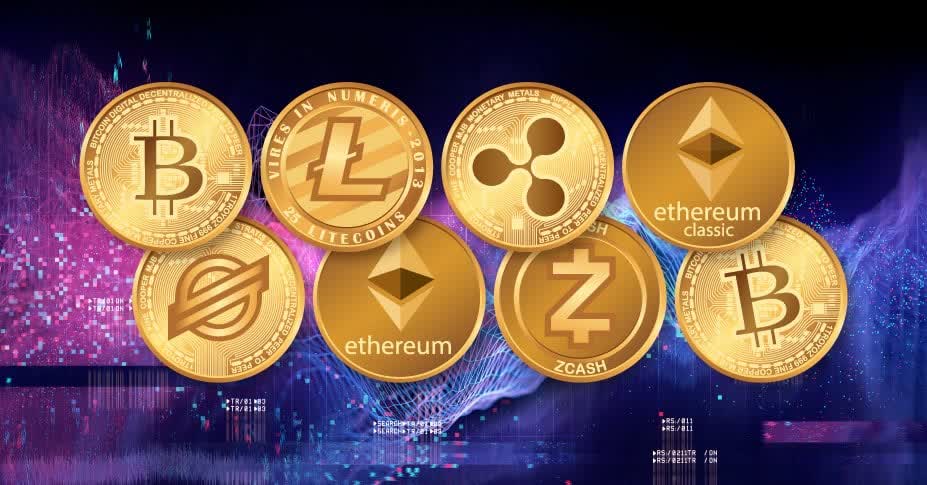
World Economic Forum WEF, Bitcoin, Digital Assets
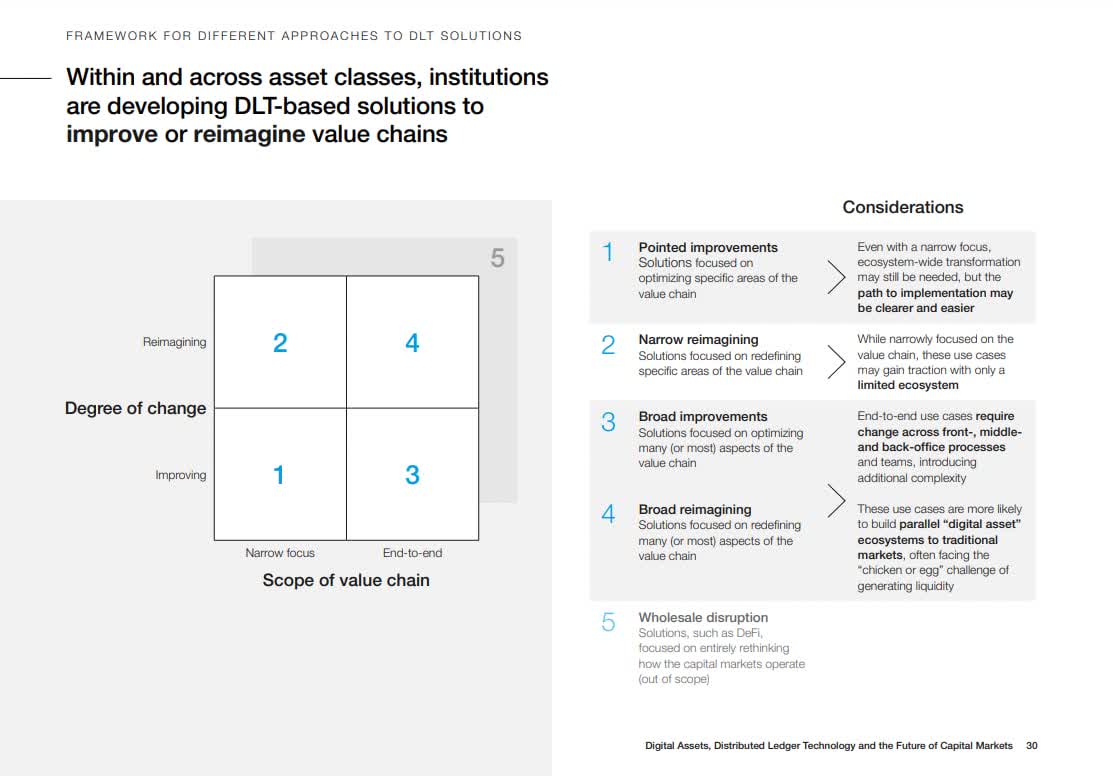
World Economic Forum WEF, Bitcoin, Digital Assets
We have certain criteria by which a change can occur, but the point is that a partial or complete rethinking of a particular system can play a role here.
We can have some kind of narrow focus (a narrowly focused niche), or we can have several niches affected at once, or several sections within one niche so that the whole industry gets under the change.
Accordingly, there are several options for the further development of events:
The first option is a partial improvement of a very narrowly targeted niche. The focus here will be on individual problematic aspects that will need to be significantly improved.
The second option is a complete rethinking and complete rework of the same narrowly focused niche.
If the first option is quite simple to implement since it requires few resources, then the second option will already affect a lot more people, a lot more money, and accordingly, it will be much more difficult to do it.
To understand this better, we can include, for example, cross-border payments in the first option. In this option, fiat money, that is, ordinary money will be converted into cryptocurrency, and vice versa. That is, it is a partial improvement in a narrowly focused sphere.
The second option would be, for example, a complete rethinking of the same cross-border payments. That is, we will not even convert the fiat money into cryptocurrency, but we will simply transfer all the money in cryptocurrency in the first place (without converting, just sending USDT, for example). That’s what would be considered a complete change in the narrowly focused sphere.
The third option for the development of events is a narrowly focused solution in any broad area.
That is, here you can take a whole wide range of services and somehow solve them or improve them using decentralized technology. There will already be rather complex work, it will be necessary to change the front, middle, and back-office processes and technologies.
The last, more realistic option is a complete reimagining of the broader scope.
That is, here we can see entire financial systems that will not only make the same cross-border payments but, in addition, we will be able to transfer our money abroad, for example, to our friends.
Then our imaginary friend simply receives this money (in cryptocurrency, of course), and without transferring it anywhere else, simply pays with it in stores right away, by purchasing an item.
The store receives this cryptocurrency (or whatever tokens that will be used in the future), and accordingly, the taxes as well, will be immediately paid from this purchase. This is what a complete reimagining on a grander scale, a complete rethinking of the financial system, would probably look like in the future.
The last fifth option is that there will be a complete reimagining of everything, as the slide says “Solutions, such as DeFi, focused on entirely rethinking how the capital markets operate (out of scope)”.
This change suggests that instead of moving there smoothly, and going on a par with the old financial system, the new developments will occur abruptly, instantly changing the entire financial system, and… do we need to state the obvious?

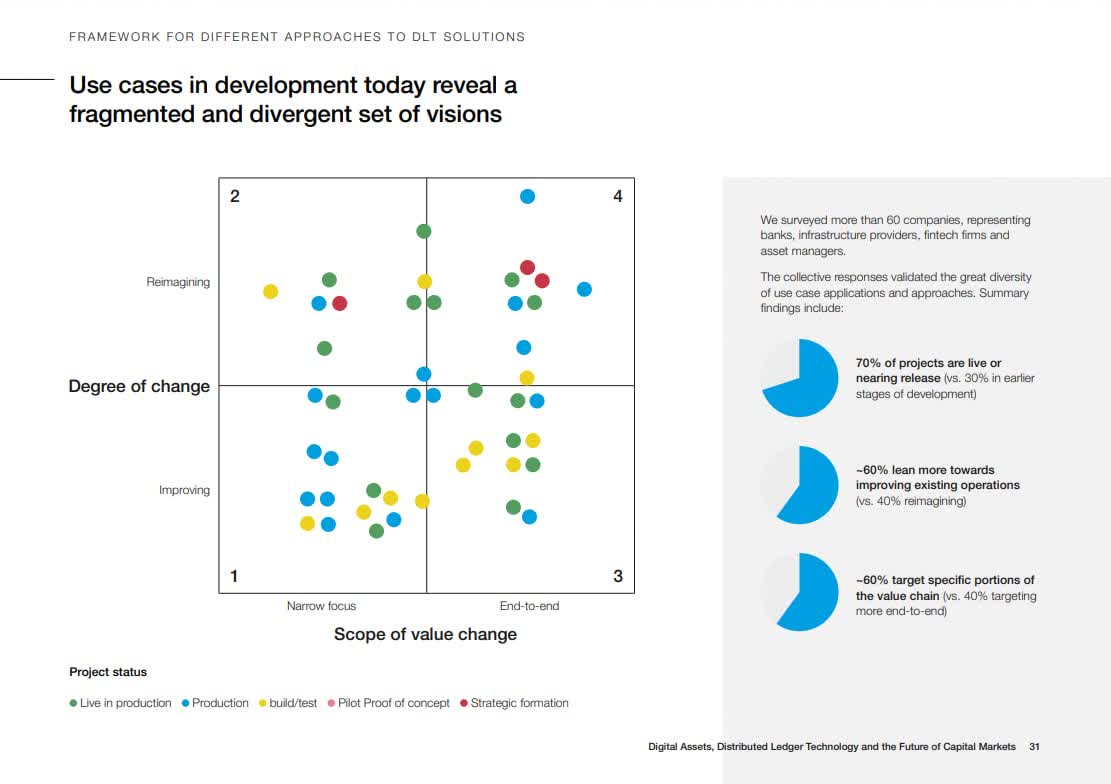
World Economic Forum WEF, Bitcoin, Digital Assets
Such a transition is very, very difficult and unlikely. Imagine the complexity of a task explaining this idea to entrepreneurs, since they need to be told how to make this transition.
The fifth option is more utopian – still can happen, but… only after one of the previous options is checked.
Of course, in order to make any changes, we need development, we need technology.
And here, on the next slide, the guys who created this report were just making a summary by talking with banks about what developments and in what areas they are currently conducting, can improve certain segments in the financial system.
As we can see here, around 70% of all projects that are currently being developed by banks and financial institutions are either already in work, or are close to completion.
It’s just that they are not public now, and the fact that we do not see them, and cannot use them yet, does not mean that there is no such thing.
We can also see here that about 60% of projects are aimed at simply improving some narrowly or broadly targeted area or industry, and 40% of the remaining projects are aimed to completely reimagine all the processes within a narrowly or broadly targeted area.
The same on the flip side, 60% of projects are aimed at some narrowly focused area, they want to either improve or rethink it, and the remaining 40% of projects are aimed at fully improving the entire ecosystem from start to finish, be it partially, or holistically.

World Economic Forum WEF, Bitcoin, Digital Assets
Here, in the graph we can see more clearly how many projects are being developed in general, in which zone, how much do they relate to a particular segment, and at what stage of development they currently are.
Next, we will look at the part of the presentation that speaks about specific solutions, and again, how those “solutions” when implemented, will generally look like.
We will talk about what kind of functionalities will be used in the future, how exactly they will be used, and how they will be developed
The main ‘avenue’ where banks are now looking is, of course, the stock market.
That is, here we will see publicly placed assets that we can trade, as users of banks, or in general, as free individuals.
The key points that we need to decide here are the primary and secondary placement of assets on this blockchain (in the blockchain-based stock market), also how these assets will move, that is, how we will transfer them to each other, and of course, how these assets will be stored there, respectively, how we can manage our assets.
By the way, most of these issues have already been resolved in certain projects, nevertheless, these issues have been written down here, because these are the key criteria by which projects will be selected.
Next, we see debt markets.
This segment is very similar to the stock market, it will include trading in securities and debt obligations. The problem that needs to be solved here, or the criteria that need to be provided in order for the project to work, are absolutely the same as in the stock markets.
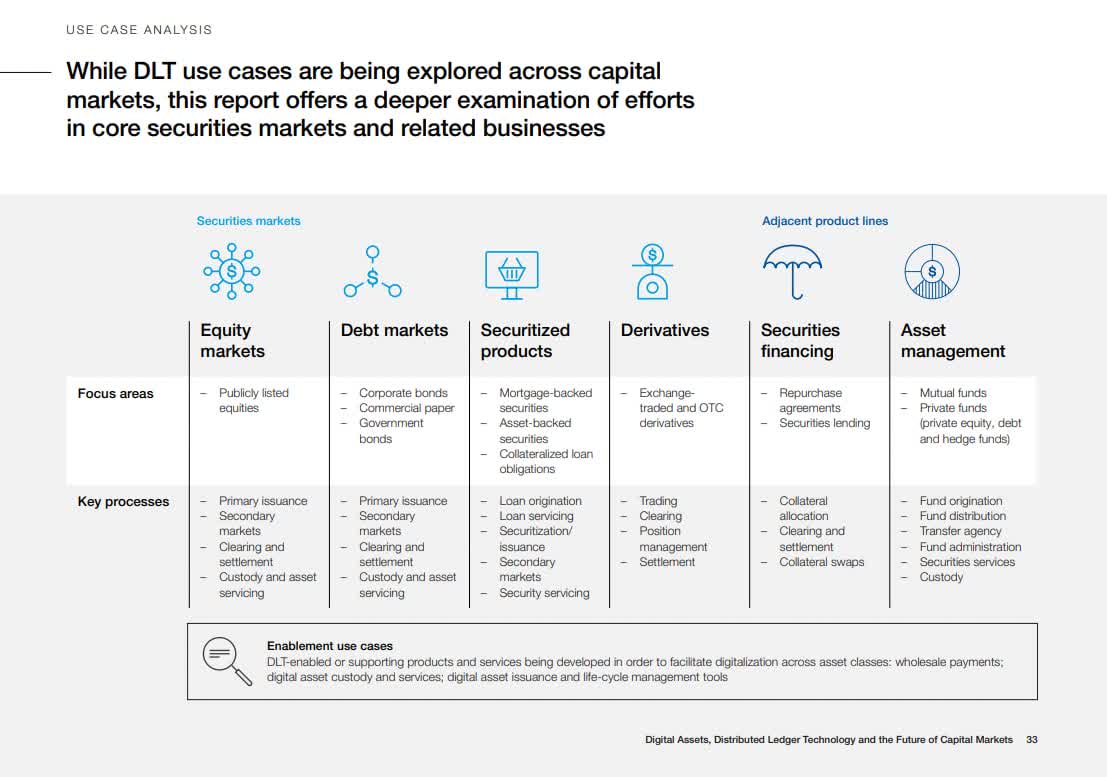
World Economic Forum WEF, Bitcoin, Digital Assets
Next, we have securitized products trading. Here we will essentially be able to trade secured securities: mortgage-backed securities, asset-backed securities, collateralized loan obligations, etc.
Here we have a fairly wide range of nuances that we need to tackle.
Firstly, this is the issuance of a loan or the issuance of a loan on the blockchain – the problem regarding the issuance needs to be resolved.
We will also need to resolve the issue of providing collateral, how it will look like, what can be provided as collateral, and how to do it.
And also it will be necessary to resolve the issue of servicing all these things, as to how it’ll be processed on the blockchain.
Next are Derivatives.
Exchange-traded and OTC derivatives trading will take place here. The questions here are very simple: how the trade itself will take place, how to build a platform on which all this will take place, and how the processing of these derivatives will generally occur, that is, the transfer from one person to another.
In fact, we believe that nothing really needs to be solved here, since most of the “swap” and farming platforms (and other DeFi projects as well) have already solved this issue a long time ago.
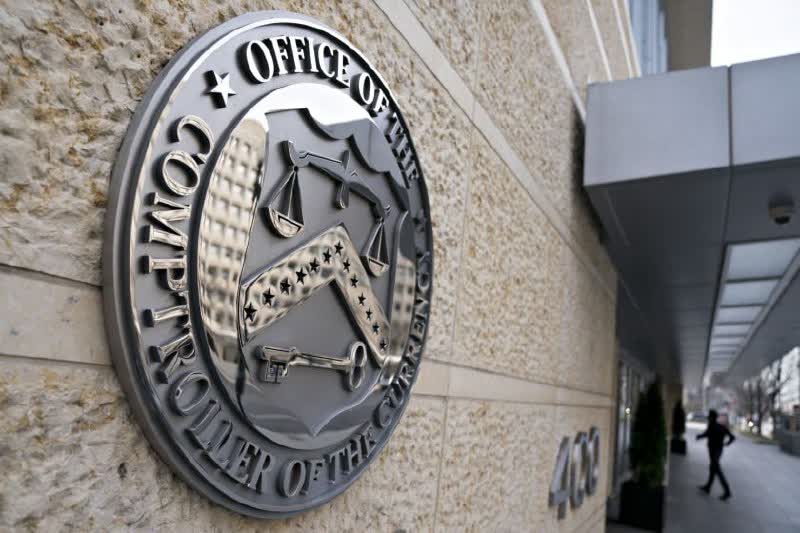
World Economic Forum WEF, Bitcoin, Digital Assets
Next, we have the “securities financing” segment.
This includes repurchase agreements and securities lending. Here we need to solve the issue of clustering, that is, how to tie your collateral to the blockchain so that it is stored there (so that you really own it).
And also we need to think through how the clearing process will be settled, and how exactly these assets will move through the network.
The last issue that banks want to focus on is the asset management segment. That is, this includes such a moment as creating our own funds or investing our money in some kind of fund, to make sure our money is put to work there.

World Economic Forum WEF, Bitcoin, Digital Assets
Here, again, we need to resolve several issues.
How these funds will be created, that is, who will have the right to create them, how this will be settled on the blockchain exactly. Also, who will manage the assets on these funds, and how these assets will be safely stored in the fund.
Many of these questions and problems have now been resolved for the most part in DeFi projects.
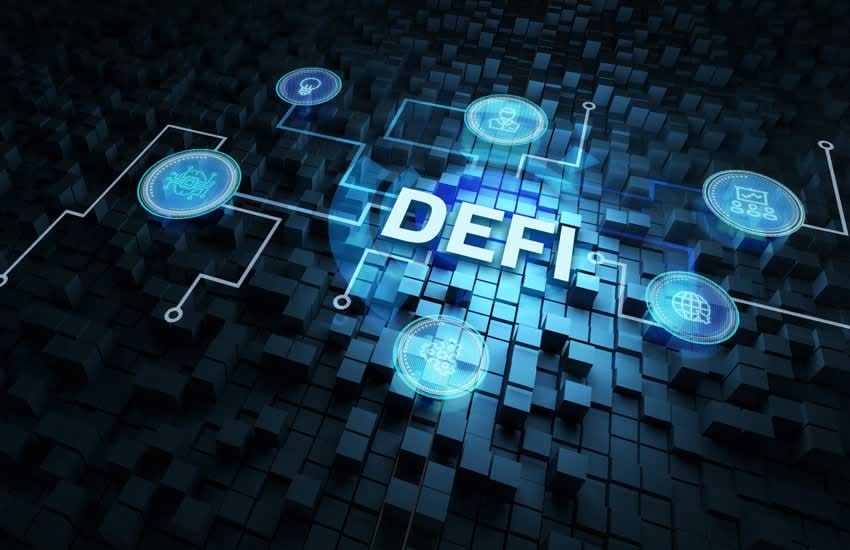
World Economic Forum DeFi has resolved a lot of said problems already
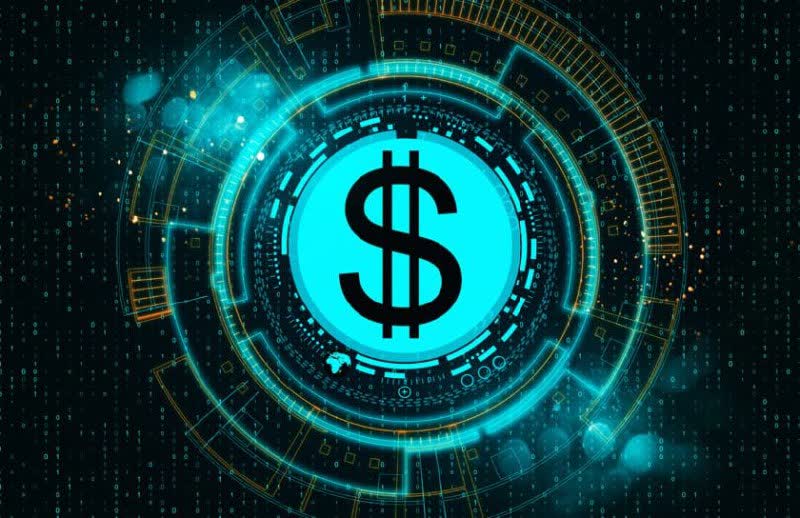
World Economic Forum WEF, Bitcoin, Digital Assets
However, the only problem is that all these projects that work today and provide us with such technology, are tied to a specific token
They are not tied to the real world, and this is exactly the bridge that we now need to build in order to bring everything that we’ve talked about today into reality.
In fact, it’s not bad that all this “movement” is now happening exclusively in a narrow circle of cryptocurrencies, because now it shows that we already have a working technology that is already functioning well and, accordingly, we can simply refine this technology and then implement it in a wider segment, that is, in the banking industry and in the world of finance.
The fact that we do not see that banks are already issuing some working projects (by the way, sometimes we can see because some banks are already openly working with cryptocurrency), does not mean that this is not happening, it just is not released to the public.
Accordingly, very soon we are going to collectively witness some significant global change.

World Economic Forum WEF, Bitcoin, Digital Assets
Technology is, of course, good, but on the other side, we have regulation of cryptocurrencies and the government, which will not stand aside when it’ll all be successfully implemented and come out on the market.
It won’t be working to their advantage, thus the government (in whichever country) most likely… won’t be too happy about it.
And, either they will be behind the release of some new cryptocurrency (most likely based on the technology of old cryptocurrencies) or they will simply have their share in any projects that will be launched into the global ecosystem.
However, the second option, it seems to us, is less likely.
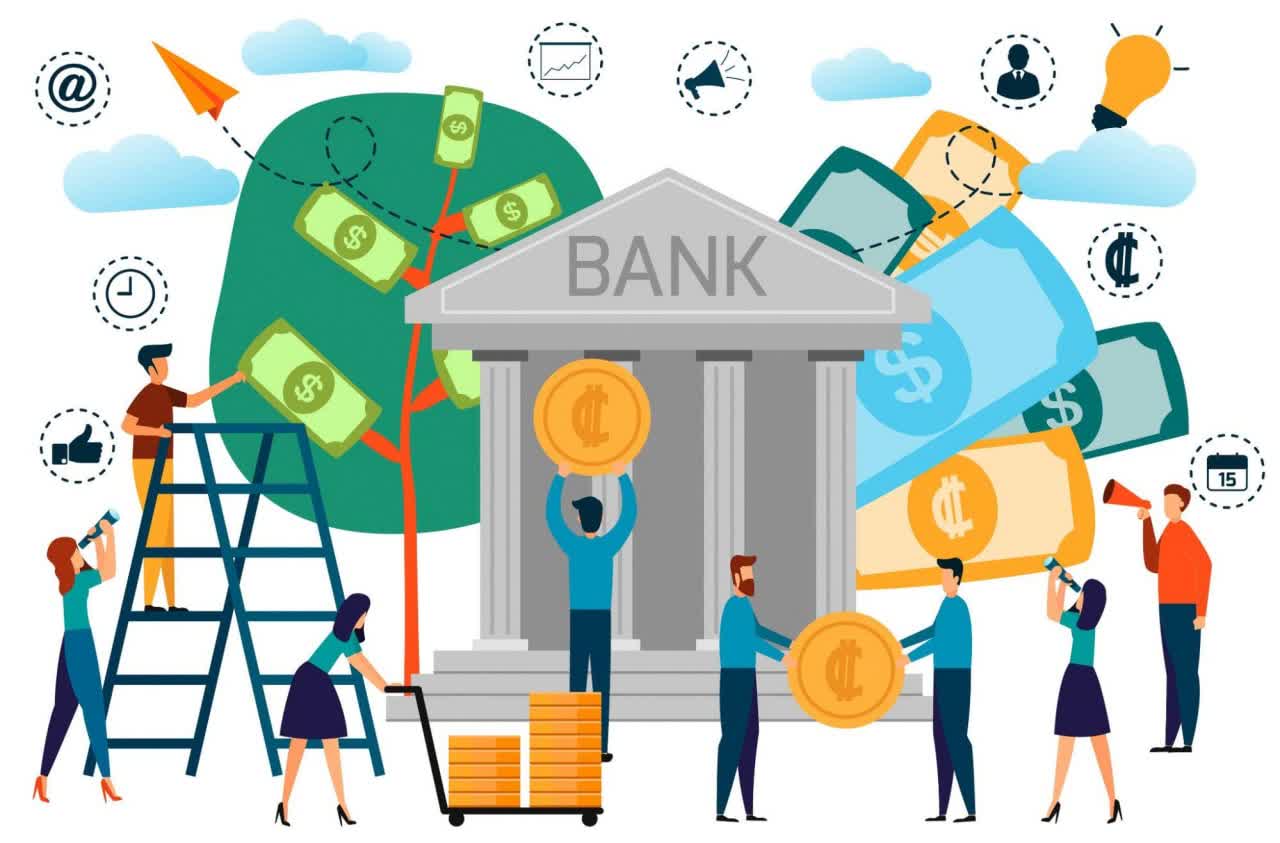
World Economic Forum WEF, Bitcoin, Digital Assets
The essence of this statement boils down to the fact that most likely, those cryptocurrencies that we now have, will never be applied on a global scale, at least most of them will simply be replaced by new cryptocurrencies that will either be released by the government or some private large corporations and companies.
Here the question arises: what will happen then with those cryptocurrencies?
Well, firstly, they will either die out, or new technologies will appear that will work precisely in a narrowly targeted segment.
Because, developing and setting up some kind of a single platform that will cover absolutely everything, will certainly require an incredible amount of resources, money, and labor, and most likely even the government and large corporations combined will not be able to implement this.

World Economic Forum Crypto has taken over the world
Therefore, we’re inclined to believe that in the future we will most likely see some kind of single platform (either by state or worldwide), for which the government will be responsible, the platform where the main processes will take place, that is the stock markets and different assets trading and listing, etc.
And it is private companies that will cover some more narrowly focused segments in the market, while the main platform will be responsible for carrying out only the main processes.

World Economic Forum Digital Yuan
Therefore, in our opinion, it will still be profitable to invest in cryptocurrency, because it will not die out entirely, but will simply be very narrowly focused on some specific areas and topics.
So far, we all should be grateful that at the moment we find ourselves at the very intersection of new technologies, therefore the money is given to us so far so easily.
Because when all this comes into common use, there will be more people coming, which then will be followed by the income becoming less, since the profit will be divided into a significantly larger number of people.
Another very important point worth mentioning is that this report says that most of these changes are planned to be implemented by the end of this year, before the beginning of 2022.
So, perhaps this will happen much earlier, and... you better be prepared for this.



